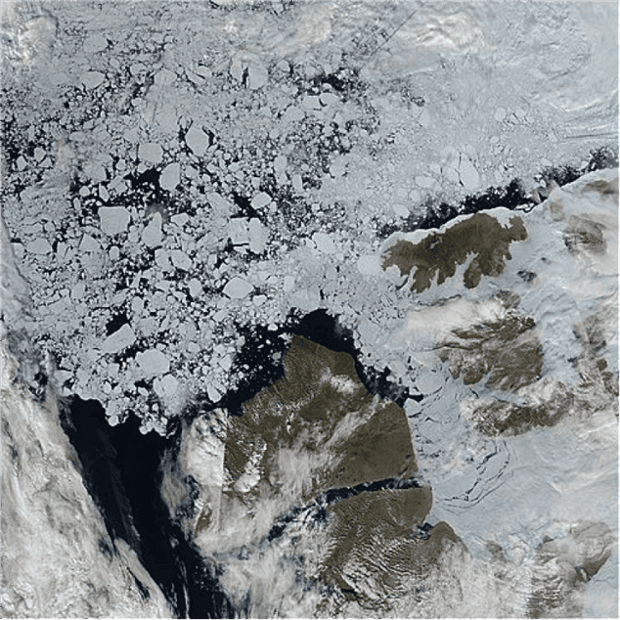
After the record smashing 2012 melting season had ended, Arctic sea ice watchers awaited the following melting season with a mix of anticipation and apprehension. Anticipation, because the annual ebb and flow of Arctic sea ice is one of the most spectacular natural events on the planet, accentuated by the dramatic loss of the past 30 years. Apprehension, because further losses would bring the Arctic yet one step closer to virtually ice-free conditions, an iconic image entailing many unpredictable consequences.

Arctic sea ice concentration on July 26, 2015. Source: University of Bremen.
But just as the previous record low reached in 2007 was followed by a short-lived rebound, the 2013 melting season proved to be sufficiently cold and cloudy to make up for the large amount of thin first year ice in the Arctic. When the following 2014 melting season was relatively cold again, with little wind to compact the ice and transport it to lower latitudes, extent and area numbers yet again ended up well above 2012 levels. Consequently, this year’s melting seasonstarted out with more volume and more multi-year ice.
The ice age distribution map below shows how much more multi-year ice there was at the start of this melting season, compared to 2012:

Arctic sea ice age distribution map in spring 2012 vs 2015. Source: University of Colorado.
The first two months of the melting season, May and June, are thought to play a crucial role in how much ice is left in September. The idea is simple: melt ponds that first show up during May and develop further during June, precondition the ice for the rest of the melting season by lowering the pack’s albedo and thus soaking up more solar radiation.
This in turn increases so-called melting momentum, which can sustain a high rate of decrease during the second half of the melting season, even if weather conditions aren’t perfect for melting, compaction and transport. Conversely, if melting momentum is low, chances of new September records are minimal, unless weather conditions during July and August favour huge losses.
Scientists are trying to quantify this influence; not an easy task given the many phases between water and ice and a lack of uniformity across the ice pack. Some researchers try to decipher satellite observations (see Rösel et al 2011), others use models to simulate melt pond cover based on atmospheric data (seeSchröder et al 2014).
This year the melting season started out relatively cold during May and it took quite a while for melt ponds to start forming on the ice pack surface. At the end ofJune, slightly more preconditioning seemed to have taken place compared to 2013 and 2014, because overall temperatures were somewhat higher than in the two prior years. But the amount of melt ponds simply didn’t come close to that of big melting years like 2007 and 2012. Any expectation of 2015 ending up close to record territory despite having more multi-year ice and volume, was effectively put on ice.
However...

LANCE-MODIS satellite image from July 19th, 2015, showing multi-year ice floes interspersed with large areas of open water and rapid break-up of fast ice in the Northwest Passage. Source: NASA.
As said, despite the importance of preconditioning for the second half of the melting season, exceptional weather conditions can still turn the tables by building up melting momentum. And that’s exactly what the Arctic has seen in the past few weeks.
Sunny weather and anomalously warm temperatures have dominated large parts of the Arctic, most importantly those areas where a lot of the thicker multi-year ice has been moved to during winter. The impact is slowly, but surely showing up on sea ice concentration maps, graphs and satellite image.
There is still virtually no chance of 2015 beating the 2012 record, but something more important for the longer term could be happening. If this weather keeps up – and according to the current forecasts, it will for at least another week – that thicker multi-year ice could receive such a beating that the slight rebound from record low levels is essentially wiped out by the time winter sets in again.
Posted by Neven on Wednesday, 29 July, 2015
 |
The Skeptical Science website by Skeptical Science is licensed under a Creative Commons Attribution 3.0 Unported License. |